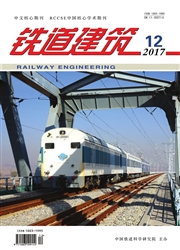

 中文摘要:
中文摘要:
钢桁梁斜拉桥是铁路大跨度桥梁的常用形式。本文基于一高速铁路钢桁梁斜拉桥线形设置的工程实际,指出设计过程中的活载大小、活载加载长度和施工过程中的道砟密度是导致钢桁梁斜拉桥成桥后实际线形与设计线形差别较大的主要原因。对该桥运营期的动态检测发现,虽然最小坡段长度不满足现有规范,但线路动态检测并无Ⅱ级及以上偏差,说明坡段长度并不影响旅客舒适性;该桥在列车动荷载作用下的实际下挠值小于设计计算值,说明目前关于钢桁梁斜拉桥的预拱度计算理论尚不够精确,可进一步完善。最后,针对已往先逐跨设置预拱度再通过坡度整改设置工后预拱度的方法,导致实际线形与设计线形相差较大的现实,提出了高速铁路钢桁梁斜拉桥线形设置的新方法。
 英文摘要:
英文摘要:
Steel trussed cable-stayed bridges are widely used as large-span bridges in railways.The background of this paper is the vertical profile setting of a steel trussed cable-stayed bridge on a high speed railway.The live load amount and loading length during design,and the density of railway ballast during construction were indicated to be the main reasons of the great difference between the designed vertical profile and the actual vertical profile.Dynamic detection in the operational period was conducted.It suggests that the short slope does not affect passenger comfort although the minimum slope length does not meet the requirements of current code,given no Ⅱ level and above deviations are detected.The actual deflection under the vehicle dynamic load is less than the designed value,and this suggests that the existing pre-camber calculation method for steel trussed cable-stayed bridge is not precise and requires improvement.The current method includes two steps: pre-camber setting span by span,and post-construction setting of pre-camber through slope adjustment.This method results in the great difference between actual and designed vertical profile.Based on the analysis,a newvertical profile setting method of steel trussed cable-stayed bridge in high speed railway was proposed.
 同期刊论文项目
同期刊论文项目
 同项目期刊论文
同项目期刊论文
 期刊信息
期刊信息
